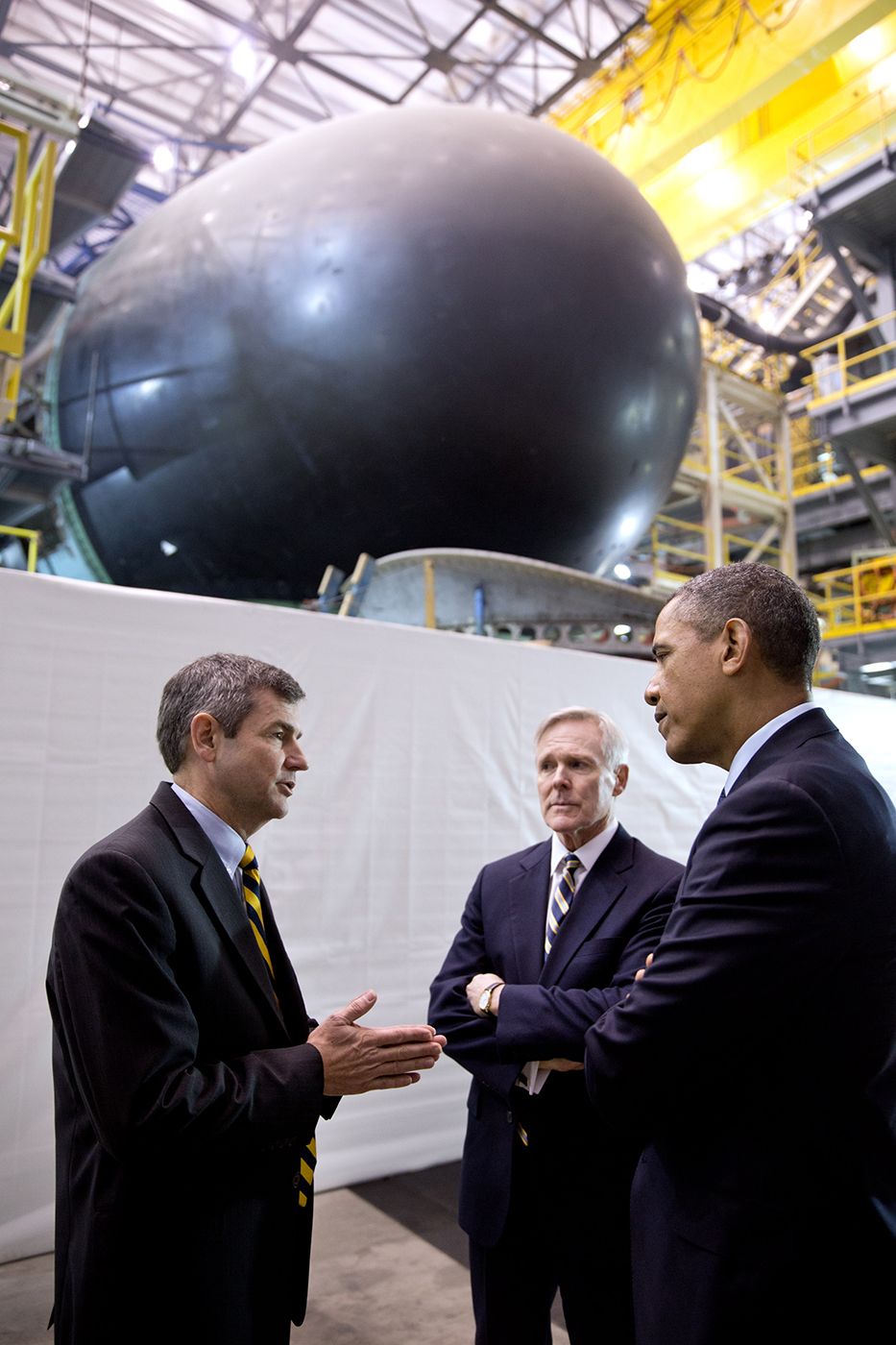The Challenge
You’re the newly appointed president and CEO of a spinoff company saddled with a huge amount of debt in an economy still reeling from an economic crisis. Your main business—building warships for the military—is grappling with quality concerns, a glut of capacity, damage from Hurricane Katrina and the prospect of budget cuts by your main client, the Pentagon. Your first and foremost challenge: managing construction of a new class of nuclear-powered aircraft carriers.
The Context
Huntington Ingalls was formed in March of 2011, when Northrop Grumman decided to spin its Newport News shipyards off as a separate company, citing a lack of synergy with its other businesses. The move thrust Mike Petters, formerly the division’s president, into the CEO role at a $6.7 billion public company—one with a time horizon far removed from Wall Street’s comfort zone.
“In the beginning, we surprised people who wanted to know where we would be next month or next quarter when we said, ‘we’re going to tell you where we will be in 2015,’” says Petters. “We like to remind people that we’re not a quarter-to-quarter business.”
The Resolution
However, Petters quickly proved his metal. Huntington Ingalls posted solid operating profit for 2013 and subsequent years, shed unprofitable legacy contracts and inked a new deal to build nuclear-powered aircraft carriers for the Navy.
The improved prospects did not go unnoticed; the company’s $41 launch share price had more than doubled by 2014 and today stands at a formidable $126.68. In fact, Huntington Ingalls’ success has led some to question why Northrop Grumman jettisoned it in the first place.
The Hurdle
 One might expect the CEO of a company deeply embroiled in building a $12.5 billion nuclear aircraft carrier to be most concerned about defense budget politics. But it’s fostering employee engagement that Petters points to as his biggest challenge. “Market challenges, political pressure, stakeholder stuff—all of that is significant, but none of it will happen if we don’t find ways to keep our people engaged in what we’re doing,” he says.
One might expect the CEO of a company deeply embroiled in building a $12.5 billion nuclear aircraft carrier to be most concerned about defense budget politics. But it’s fostering employee engagement that Petters points to as his biggest challenge. “Market challenges, political pressure, stakeholder stuff—all of that is significant, but none of it will happen if we don’t find ways to keep our people engaged in what we’re doing,” he says.
The Solutions
Petters invests a lot of personal effort in addressing the engagement issue, spending about half of his time on human capital and leadership development and engagement. Under his direction, the company launched a leadership networking program. Employees in leadership roles—from front-line supervisors on up—are brought together to work on case studies. “It was started on the premise that there’s probably nothing in our business that we’re seeing for the first time—so how do we build a network so that our leaders can call on people who may have seen a particular problem before?” explains Petters. “It gives us the chance to help our leaders understand how we think about things as a group, but also to work with people from different parts of the business.”
 While Huntington Ingalls offers formal incentive programs around metrics involving safety, quality, cost and schedule, Petters believes in going a lot further. “It’s a bit shortsighted to suggest that we can incentivize someone to be a better person,” he says, adding that the company also offers a lecture series for senior leaders and conducts Gallup surveys to explore what “moves the needle” in terms of engagement. “My view is that getting the least empowered person in the company to confidently contribute to your team is your day job as a leader—and we want to give our leaders the tools to do that.”
While Huntington Ingalls offers formal incentive programs around metrics involving safety, quality, cost and schedule, Petters believes in going a lot further. “It’s a bit shortsighted to suggest that we can incentivize someone to be a better person,” he says, adding that the company also offers a lecture series for senior leaders and conducts Gallup surveys to explore what “moves the needle” in terms of engagement. “My view is that getting the least empowered person in the company to confidently contribute to your team is your day job as a leader—and we want to give our leaders the tools to do that.”
“We need to be more thoughtful about folks who have great ideas but don’t feel empowered to participate,” he says. “This is a complex issue with lots of pieces to it, but it’s certainly what drives our business—and ultimately what will be the key measure of our future success.”

Chief Executive Group exists to improve the performance of U.S. CEOs, senior executives and public-company directors, helping you grow your companies, build your communities and strengthen society. Learn more at chiefexecutivegroup.com.
0

1:00 - 5:00 pm
Over 70% of Executives Surveyed Agree: Many Strategic Planning Efforts Lack Systematic Approach Tips for Enhancing Your Strategic Planning Process
Executives expressed frustration with their current strategic planning process. Issues include:
Steve Rutan and Denise Harrison have put together an afternoon workshop that will provide the tools you need to address these concerns. They have worked with hundreds of executives to develop a systematic approach that will enable your team to make better decisions during strategic planning. Steve and Denise will walk you through exercises for prioritizing your lists and steps that will reset and reinvigorate your process. This will be a hands-on workshop that will enable you to think about your business as you use the tools that are being presented. If you are ready for a Strategic Planning tune-up, select this workshop in your registration form. The additional fee of $695 will be added to your total.

2:00 - 5:00 pm
Female leaders face the same issues all leaders do, but they often face additional challenges too. In this peer session, we will facilitate a discussion of best practices and how to overcome common barriers to help women leaders be more effective within and outside their organizations.
Limited space available.

10:30 - 5:00 pm
General’s Retreat at Hermitage Golf Course
Sponsored by UBS
General’s Retreat, built in 1986 with architect Gary Roger Baird, has been voted the “Best Golf Course in Nashville” and is a “must play” when visiting the Nashville, Tennessee area. With the beautiful setting along the Cumberland River, golfers of all capabilities will thoroughly enjoy the golf, scenery and hospitality.
The golf outing fee includes transportation to and from the hotel, greens/cart fees, use of practice facilities, and boxed lunch. The bus will leave the hotel at 10:30 am for a noon shotgun start and return to the hotel after the cocktail reception following the completion of the round.